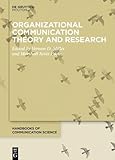Organizational Communication Theory and Research / ed. by Vernon D. Miller, Marshall Scott Poole.
Material type: TextSeries: Handbooks of Communication Science ; 8Publisher: Berlin ; Boston : De Gruyter Mouton, [2024]Copyright date: 2024Description: 1 online resource (XII, 641 p.)Content type:
TextSeries: Handbooks of Communication Science ; 8Publisher: Berlin ; Boston : De Gruyter Mouton, [2024]Copyright date: 2024Description: 1 online resource (XII, 641 p.)Content type: - 9783110718393
- 9783110718607
- 9783110718508
- 658.45 23/eng/20240620
- HD30.3
- online - DeGruyter
- Issued also in print.
| Item type | Current library | Call number | URL | Status | Notes | Barcode | |
|---|---|---|---|---|---|---|---|
 eBook
eBook
|
Biblioteca "Angelicum" Pont. Univ. S.Tommaso d'Aquino Nuvola online | online - DeGruyter (Browse shelf(Opens below)) | Online access | Not for loan (Accesso limitato) | Accesso per gli utenti autorizzati / Access for authorized users | (dgr)9783110718508 |
Frontmatter -- Preface to Handbooks of Communication Science Series -- Contents -- Preface -- Section I: Theory and Methods -- Chapter 1 Systems Theory and Ecosystems of Organizational Communication -- Chapter 2 Emerging Trends and Topics in Research on the Communicative Constitution of Organizations -- Chapter 3 Can We Meet at the Alter? Doing Justice through Organizational Communication -- Chapter 4 Quantitative Methods in Organizational Communication -- Chapter 5 Qualitative Methods in Organizational Communication -- Section II: Processes -- Chapter 6 Organizational Communication Design -- Chapter 7 Leadership Communication -- Chapter 8 Organizational Entry Processes -- Chapter 9 Conflict and Negotiation -- Chapter 10 Diffusion -- Chapter 11 The Role of Social Identity in Organizational Communication Over Time -- Chapter 12 Coordination -- Chapter 13 Stakeholders and Organizational Change -- Chapter 14 Communication, Power, and Organizational Politics -- Chapter 15 Piecing Together Inclusion: A Critical Overview of Organizational Inclusion Research and Praxis -- Section III: Contexts -- Chapter 16 Supervisor-Employee Communication -- Chapter 17 Team Process -- Chapter 18 Networks -- Chapter 19 Organizational Structure -- Chapter 20 Generational Shifts: The Emergence of Visibility in Globalization Research -- Chapter 21 Types of Organizations -- Section IV: Technology -- Chapter 22 Artificial Intelligence and Organizational Communication -- Chapter 23 Social Media, Organizations, and Organizing -- Chapter 24 Distributed Collaboration -- Section V: Emerging Areas -- Chapter 25 Wellness in the Workplace -- Chapter 26 Organizing Social Change -- Chapter 27 Work and Life Communication -- Chapter 28 Military Exit and Reentry to Family, Society, and Work -- Chapter 29 Corporate Social Responsibility Communication -- Chapter 30 From Crisis Response to High Resilience Organizing -- Author Biographies -- Index
restricted access online access with authorization star
http://purl.org/coar/access_right/c_16ec
The Handbook of Organizational Communication Theory and Research offers concise, but thorough reviews of important research on traditional and emerging areas in organizational communication. Section One, Theory and Methods, provides an overview of the field’s history, prominent theories, and methodologies. Section Two, Processes, focuses on primal processes, such as leadership, organizational entry, conflict, power, and inclusion. Section Three, Contexts, focuses on the settings where organizational communication occurs, including teams and workgroups, networks, and organizational structure. Section Four, Technology, considers the development and introduction of new media and intelligent technologies into organizations. The final section, Emerging Areas, addresses communication issues associated with changing environmental, social, and political upheavals, including wellness, corporate social responsibility, and crisis response. The Handbook of Organizational Communication Theory and Research covers topics of pressing interest to current scholars and practitioners, many of which have not been addressed in previous handbooks.
Issued also in print.
Mode of access: Internet via World Wide Web.
In English.
Description based on online resource; title from PDF title page (publisher's Web site, viewed 20. Nov 2024)


